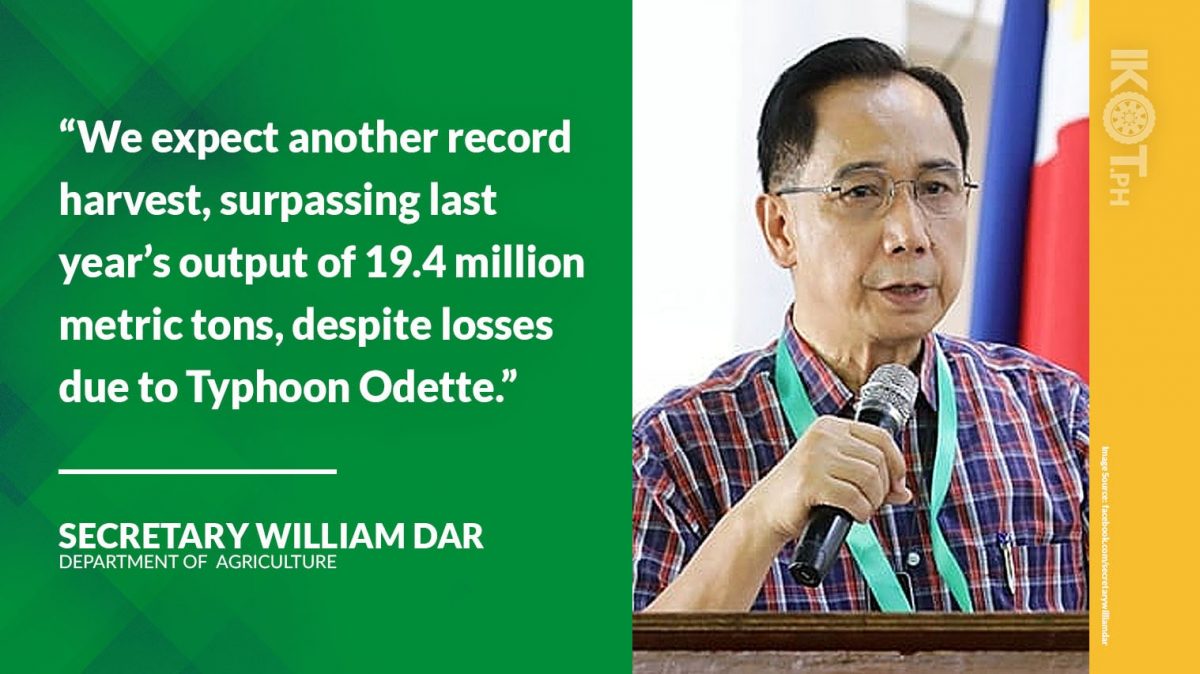Despite what is perceived as a most challenging year, the Philippine agriculture sector continues to demonstrate strength and resilience. Thanks to the breakthroughs and reforms instituted by the Duterte administration, particularly in the rice industry.
In the first three quarters of 2021, the country’s agriculture sector posted a negative growth of one percent (-1%), from a similar -0.2% in 2020.
The decline is mainly due to the negative impact of the African Swine Fever (ASF), which has lingered since mid-2019, pulling down the performance of the livestock subsector by a double-digit figure.
While the figures may seem discouraging at face value, a deeper look into them would paint a different picture.
“Were it not for the ASF, the agri-fishery sector would have registered a positive growth in 2020 and this year,” said Agriculture Secretary William Dar, adding that the combined efforts against the ASF are now gaining headway as disease incidence is waning.
“Amid the COVID-19 pandemic, ASF and other challenges, we persevered and moved on, partnering strongly with the local government units (LGUs), the private sector, agri-fishery industry stakeholders, state universities and colleges (SUCs), farmers’ cooperatives and associations (FCAs), and several international funding institutions,” Dar added.
“Despite the damage caused by ‘Typhoon Odette,’ we in the ‘OneDA Family’ are confident that we have performed better this year.”
“Despite the damage caused by ‘Typhoon Odette,’ we in the ‘OneDA Family’ are confident that we have performed better this year, providing more services and interventions despite our limited budget. Hence, we are optimistic that the 2021 agriculture sector performance is better than the previous year. We would be happy with a one-percent positive growth,” the agriculture chief said.
“This year, the sector will be bannered again by the crops sub-sector, particularly palay. We expect another record harvest, surpassing last year’s output of 19.4 million metric tons (MMT), despite losses due to Typhoon Odette,” the agriculture head added.
DA’s Philippine Integrated Rice Program Director Dionisio Alvindia said initial estimates show that 2021 palay production could reach at least 19.95 MMT, combining the January-September output of 12.55 MMT and the expected fourth quarter (Q4) harvest of at least 7.4 MMT.
The PIRP includes the DA national rice program (NRP), Rice Competitiveness Enhancement Fund (RCEF), and Rice Resiliency Project (RRP) that covers non-RCEF areas.
Alvindia said that aside from the regular budget allotted for the NRP, at P7 billion in 2020, Congress has approved a supplemental budget to pursue RRP2, which provided rice farmers free seeds and fertilizers.
To date, a total of 1.08 million bags of hybrid and 262,964 bags of inbred seeds were distributed to 946,793 farmers in 16 regions nationwide.
“The country’s rice industry is on the right track.”
“In all, the country’s rice industry is on the right track, as we observe the mid-term anniversary in March 2022 of the Rice Tariffication Law (RTL) that saw implementation of the annual P10-billion RCEF support to rice farmers,” he stressed.
To date, among the notable accomplishments of the RCEF are:
· Increase in average palay production to 4.26 mt per hectare (ha) from 3.64 MT/ha in 42 RCEF provinces;
· Decrease in production cost, per PSA data from P12.52/kg to P11.52/kg; an8d
· Decrease in inbred seed utilization via manual method by 33%, from 90 kg/ha to 60 kg ha; and further decrease in seed utilization using mechanical seeder by 67% to 30 kg/ha.
·
With these initial favorable outcomes, Alvindia said the RCEF targets could be attained in the next three years, namely:
· Average palay harvest of 5 MT/ha, from 3.64 MT/ha;
· Average palay production cost of P9/kg to P10/kg;
· Decrease in postharvest losses by 2% to 3%; and
· Increase in average farmers’ gross income by P10,000/ha, according to studies by the DA’s Philippine Rice Research Institute (PhilRice). The increase in yield and decrease in seeding rate translate to a decrease in the cost of production (COP), thus providing farmers an additional gross income of P10,000 per hectare, at P19/kg of palay (14% moisture content or MC).
RCEF interventions
The DA-PhilRice as of November 30, 2021, has provided a total of 1,144,640 20-kg bags (74% of the target) of certified inbred seeds to 372 municipalities/cities in 42 RCEF-covered provinces for dry season (DS) 2022, from Sept. 16, 2021 to Mar. 15, 2022.
For the 2021 wet season (WS), March 16, 2021 to September 15, 2021, PhilRice has provided a total of 1,764,841 20-kg bags to 713,052 farmers, tilling a total of 813,909 hectares, in 739 municipalities/cities in 42 RCEF provinces.
For the RCEF farm mechanization component, the DA’s Philippine Center for Postharvest Development and Mechanization (PhilMech) has distributed 11,923 units of various machinery and equipment, procured 8,628 units for 6,284 FCAs and LGUs, benefiting 682,502 farmers.
Under the RCEF extension component, a total of 58,728 farmers, extension workers and specialists were trained; developed, produced and distributed 1.26 million sets of various IEC materials; and assisted 1,231 FCAs on enterprise development. This component is co-implemented by the DA’s Agricultural Training Institute (ATI), PHilMech, PhilRice, and Technical Education and Skills Development Authority (TESDA).
Lastly, for the credit component — co-implemented by the Land Bank of the Philippines and Development Bank of the Philippines — a total of P927 million was lent to 5,288 individual borrowers and FCAs, with a combined membership of 32,714 farmers.


